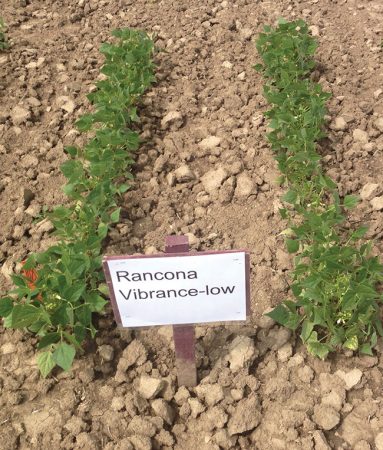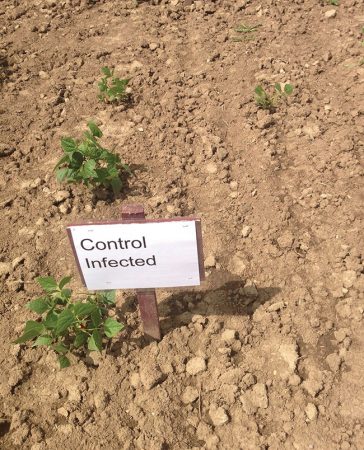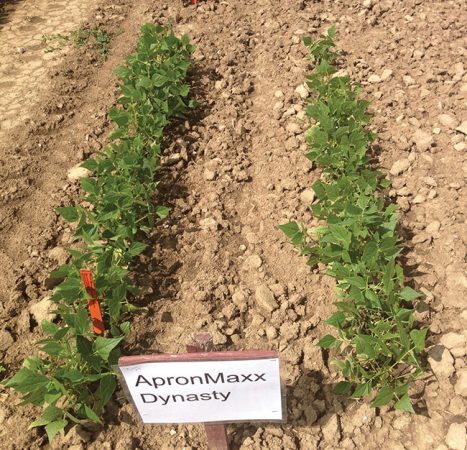
Features
Diseases
A sneaky yield robber: root rot in dry bean
Root rot research tackles this ornery foe of dry bean crops.
October 12, 2019 By Carolyn King
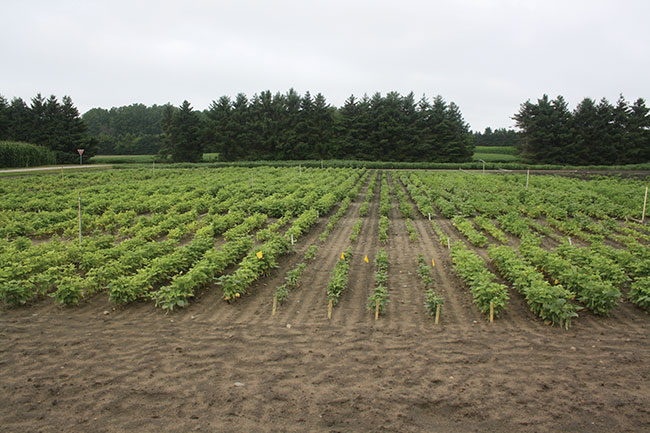 Hybrids exhibit different reactions to Goss’s wilt, with brown plants severely affected. Photo courtesy of Jamie Larsen.
Hybrids exhibit different reactions to Goss’s wilt, with brown plants severely affected. Photo courtesy of Jamie Larsen. Root rot is the number one fungal disease in dry bean, no question about it,” says Chris Gillard, an associate professor of dry bean agronomy and pest management at the University of Guelph’s Ridgetown Campus. As a result, Ontario researchers are working on ways to fight this tough-to-control disease.
“Root rot affects at least a small percentage of the dry bean plants in every field in every year, and in some years, the impacts are dramatically worse. The problem is, the disease is happening below ground for the first while, so it is a hidden pest. People don’t realize a problem is starting in the roots.”
“Yield reductions from root rot in dry bean are typically reported to be between about 10 and 33 per cent. But it may be that the disease only affects a portion of a field, perhaps an area that is a little more low lying and wet,” notes Jamie Larsen, the dry bean breeder with Agriculture and Agri-Food Canada (AAFC) at Harrow.
Gillard explains that a complex of several pathogens can cause the disease in dry bean. In Ontario, the main pathogens are Fusarium and Rhizoctonia. “Fusarium causes roughly three-quarters of the problem and Rhizoctonia about one quarter. Both pathogens are present in most bean fields, but Fusarium is much more common than Rhizoctonia, within a field and between fields.”
Below-ground symptoms of root rot may include reddish-brown lesions on the roots and root death. Above-ground symptoms may include seedling death, stunting, wilting, yellowing of lower leaves and poor pod filling.
“Root rots can reduce plant stands and decrease plant vigour, causing stunting and slower crop development,” Gillard says. “Cool, wet weather just after planting promotes the initial infection of the plant. Typically, the pathogens don’t kill the plant right off, although they can. Usually, they damage and stunt the root system, but you don’t notice the problem until the weather turns hot and dry in July and August. Then the plant really needs its roots to pump up water to keep the plant healthy and growing, but it doesn’t have the root system to do that. People call Fusarium and Rhizoctonia ‘dry rots’ because the damage to the plant becomes very evident when the weather turns dry.”
“Usually, they damage and stunt the root system, but you don’t notice the problem until the weather turns hot and dry in July and August.”
He notes, “Soil compaction, poor drainage, and lack of tiling all increase root rot problems. Short rotations with too many bean crops also favour the disease. The pathogens live in the soil from year to year, and their populations will increase over time if you grow susceptible crops more frequently in your rotation.”
Unfortunately, there is no silver bullet for root rot. Gillard says, “There is no product in a jug that is going to solve all your root rot problems. Seed treatments help protect the plants for the first few weeks. After that, you need good crop management, including a whole laundry list of practices: good crop rotations, good soil health, high organic matter, and good drainage. If you’ve got a healthy, productive, well-managed soil with minimal compaction, you will have a lot less problems with root rot.”
“There is no product in a jug that is going to solve all your root rot problems. Seed treatments help protect the plants for the first few weeks. After that, you need good crop management.”
Larsen adds, “From what we have seen, no dry bean lines in Ontario are resistant to root rot. Some lines have lower levels of the disease, but just marginally lower. For instance, some of the black beans in our testing seem to have a little less root rot, but we’re not sure exactly why.”
Seed treatment evaluations
Gillard’s research group conducts root rot seed treatment trials every year, which include both standard seed treatments and the latest products on the market. This work is providing a long-term dataset on the efficacy of these products, for the use of bean growers and agronomists. Current funders of this research include the Ontario Bean Growers (OBG) and AAFC through the Canadian Agricultural Partnership (CAP).
In these trials, all the plots, including the control plots, are inoculated with a root rot pathogen. One set of plots is inoculated with two different rates of Fusarium, and the other set with two different rates of Rhizoctonia. The inoculum is placed in the seed furrow so the pathogen can potentially attack as soon as the seed starts to germinate.
“The soil at the testing site already has a native root rot pressure, and we add extra disease pressure by inoculating our trials. We want high disease pressure because dry bean is remarkably plastic when it comes to plant stands,” he explains. “In separate plant population/row width studies, we have found that we can reduce dry bean plant stands by 40 per cent and not get a yield impact, all other things being equal. So we have to apply enough disease pressure to reduce the stand of the infected control by at least half, because we know it will take a 50 per cent reduction in the stand to give a yield impact at the end of the day.”
For these trials, Gillard’s group uses small, two-row plots, where each row is two metres long. “We know exactly how many seeds we put in the ground, so we have highly accurate stand counts and plant vigour data, which are crucial for seed treatment studies.”
The trials reflect the treatment practices commonly used by bean growers. “Dry bean production in Canada is almost 100 per cent certified seed use, and it is not uncommon to see four- or five- or six-way combinations of seed treatments on dry bean seed. Everybody is using Cruiser Maxx Bean, a seed treatment that has been used on dry beans for about 15 years. [This product includes the fungicides Maxim (fludioxonil) and Apron (metalaxyl) and the insecticide Cruiser (thiamethoxam).] And almost everybody has Dynasty (azoxystrobin), which is based on our research showing its effectiveness on anthracnose, a seed-borne fungal pest. Some seed lots also have the fungicide Vibrance (sedaxane). Rancona (ipconazole) was just registered in Canada for the 2018 crop year, and is now added to some seed lots.”
In Gillard’s trials, the seeds in the control plots only have a Cruiser treatment, while all the others have seed treatments that include fungicides. “We start with a basic treatment of Cruiser Maxx Bean, and then add other products and look at the additive effect. For instance, we would look at the effect of adding Dynasty to the Cruiser Maxx Bean, or Vibrance on top of Dynasty to the Cruiser Maxx Bean, and so on. We get up to six- or seven-way combinations.”
He notes, “We don’t get a lot of new seed treatment products coming in, but when we do get new products, we add them into the mix to see what additive effect they provide. We also test products that are registered in Canada on other pulse crops, like EverGol Energy (penflufen, prothioconazole and metalaxyl) and Insure Pulse (pyraclostrobin, fluxapyroxad and metalaxyl). Since such products are already registered for other pulse crops, it wouldn’t be hard to add dry bean to that list, if we see some benefit on dry bean.”
The detailed trial results are available online in Gillard’s annual research reports. He summarizes, “[In years when conditions favour root rot], the effect of seed treatments can be huge. In other years, you can’t really tell the treatments apart from the control. This year was a good example of that. Planting was delayed due to the cool, wet spring, but after we finally planted, the weather turned hot and dry, which reduces the threat from root rots. So the plant stand differences between the untreated and treated plots were relatively small and differences in plant vigour disappeared quickly.
“In a year with good conditions for root rot, we typically see a difference between fungicidal seed treatments and no fungicidal seed treatment up to 30 to 35 days out from planting. By that point, plant vigour and health generally recover, but the stand loss doesn’t recover, and of course, the plants can rapidly go backwards if the weather turns dry.”
Gillard also says, “We don’t always see a response from the add-on products, but we typically see more consistent results as we add more products. So we may not see an increase in emergence when we add Vibrance to the seed, but when we do see a response it is a positive response.”
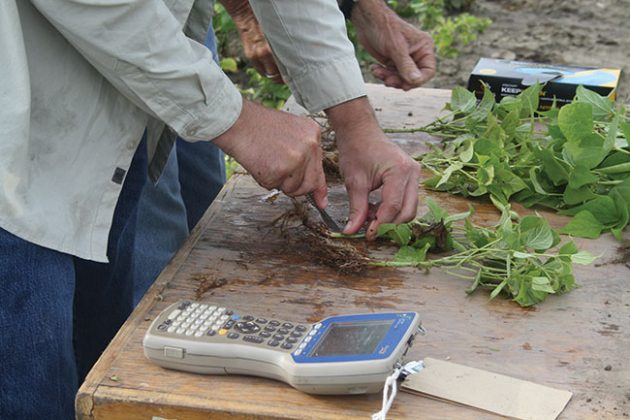
Root rot screening currently requires slicing the roots by hand. Larsen and Wally will be looking for more efficient screening methods. Photo courtesy of Jamie Larsen/AAFC-Harrow.
Typically, for about the first 10 days to two weeks after planting, the seed treatments will bring the pathogen populations down to the levels in the non-inoculated soil. He notes, “You can only expect seed treatments to really protect the plant for about 14 to 21 days. By that time, the root system has grown beyond the zone of influence of the seed treatment and the seed treatment itself is breaking down.”
Several of Gillard’s other research studies also have related to root rot. For instance, his research group recently completed a study looking at the effect of soil health on dry bean growth and development. “The single biggest factor that we measured that had the biggest impact on crop growth was soil compaction, which doesn’t come as a surprise.”
“The single biggest factor that we measured that had the biggest impact on crop growth was soil compaction, which doesn’t come as a surprise.”
His group has also conducted several nitrogen fertilizer studies. Fertilizer may improve the yield in a field affected by root rot, but it doesn’t treat the disease. Gillard says, “A lot of growers use nitrogen to help combat root rot, but we only measured a significant yield response about half the time or less. We get a response to nitrogen fertilizer up to about 50 kilograms per hectare; there is not a benefit to going higher than that.”
Seeking root rot resistance
Larsen, who started as AAFC-Harrow’s dry bean breeder in 2018, includes root rot as one of the disease resistance priorities in his breeding program. He says, “Dry bean varieties with stronger root rot resistance would improve yields and provide greater yield stability and predictability. They might also allow growers to expand their bean production back into certain fields that have had problems with root rot in the past.”
However, developing root rot-resistant varieties is an uphill battle. “Resistance to root rot in dry bean is a quantitative trait, meaning that lots of genes are involved. Some genes may provide a little more resistance than others, but we don’t know which ones. To develop a line that is truly resistant – to get all those root rot resistance genes together in a package that also meets the class, quality and yield guidelines and has everything else growers look for – is challenging.”
AAFC-Harrow’s root rot nursery provides the root rot ratings for Ontario dry bean varieties. Larsen says, “We run the registration performance trials and also test some of the advanced lines from our breeding program and the University of Guelph’s breeding program.”
This nursery has been operating since 1979. At that time, the soils were inoculated with three root rot species: Fusarium solani, Rhizoctonia solani, and Pythium ultimum. Since then, the nursery has had continuous dry bean production, with no crop rotation, to ensure high levels of inoculum in the soil. Also, irrigation is applied to the plots to promote the disease. A few years ago, Debra McLaren, a research scientist at AAFC-Brandon, tested samples from the nursery and found those three pathogens are still present in the soil at significant levels and still causing the disease in dry bean plants.
Larsen has examined the varietal data from the nursery for 2009 to 2018. “We found no trend at all towards improved root rot resistance in the varieties tested over that time period.” This underscores how difficult it is to improve root rot resistance. The data also showed that root rot symptoms occur every year, but they are more severe in some years, which is likely tied to year-to-year differences in soil moisture and temperature.
“We found no trend at all towards improved root rot resistance in the varieties tested over that time period.”
He is currently working with Owen Wally, the pulse pathologist at AAFC-Harrow, on a major project to improve disease resistance in dry bean. The project includes: studies on bacterial blights (common bacterial blight, bacterial brown spot and halo blight); Harrow’s ongoing operation of nurseries for root rot, white mould and common bacterial blight; and development of molecular markers to screen for disease resistance genes and development of dry bean lines with improved disease resistance. This research is funded by OBG and AAFC through CAP.
“Work by dry bean breeders to develop root rot-resistant lines goes back into the 1980s,” Larsen notes. “Several lines classified as being resistant have been developed, and some of those lines have been incorporated into our breeding program, and sometimes we see lines with reduced symptoms resulting from using those lines as parents. Our plan is to ramp up that work.”
For example, in the past, the nursery planted dry beans in long rows and then selected five plants randomly to rate for disease levels. Now Larsen and Wally are using hill plots, which make the plant distribution more compact, so the researchers have more space for testing more dry bean plants. They will also be putting a greater focus on testing the offspring of lines with root rot-resistant parents.
Wally and Larsen are also trying to develop more efficient ways to rate very large numbers of plants for resistance to root rot. “Currently, root rot screening is a lot of work. You have to grow the plants in the field, dig them up, wash the roots, and slice every single plant individually with a scalpel, in order to do the disease rating. Obviously, as you have more breeding material, that becomes a much more daunting task,” Larsen explains.
“We will continue to do the root rot rating that way, but we will also be exploring other possible methods. For instance, we are going to try using canopy temperature to screen for root rot. We suspect that plants where the roots have been damaged by root rot might have a higher canopy temperature because they can’t draw as much moisture out of the soil, so they won’t be transpiring as much and therefore their canopy will be hotter.”
“We suspect that plants where the roots have been damaged by root rot might have a higher canopy temperature because they can’t draw as much moisture out of the soil.”
Larsen and Wally have started some preliminary work on this approach. They will be experimenting with various ways to measure the canopy temperature, such as using a drone with an infrared (heat sensing) camera and using infrared thermometer guns. And they will be collecting data to see if canopy heat is related to root rot levels and if measuring the canopy temperature might offer an efficient, accurate way to quickly screen a lot of breeding material.
The researchers are also planning to try a protocol developed at North Dakota State University for laboratory screening of dry bean lines for root rot. Larsen notes, “This protocol involves inoculating the seedlings with a root rot pathogen just as the seedlings are coming out of the ground in that hook stage. This early inoculation allows you to screen material very early so you don’t have to wait many weeks until the plant is fully grown.”
When conditions favour root rot, this disease can be a tough enemy for dry bean growers. Ongoing research is working to find more effective strategies to help growers fight back.
